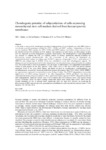Mostrar o rexistro simple do ítem
Chondrogenic Potential of Subpopulations of Cells Expressing Mesenchymal Stem Cell Markers Derived from Human Synovial Membranes
| dc.contributor.author | Arufe, M.C. | |
| dc.contributor.author | Fuente, Alexandre de la | |
| dc.contributor.author | Fuentes Boquete, Isaac Manuel | |
| dc.contributor.author | De-Toro, Javier | |
| dc.contributor.author | Blanco García, Francisco J | |
| dc.date.accessioned | 2015-06-17T10:17:30Z | |
| dc.date.available | 2015-06-17T10:17:30Z | |
| dc.date.issued | 2010-07-21 | |
| dc.identifier.citation | Arufe MC, Fuente A, Fuentes I, Toro FJ, Blanco FJ. Chondrogenic potential of subpopulations of cells expressing mesenchymal stem cell markers derived from human synovial membranes. J Cell Biochem. 2010;111(4):834-845 | es_ES |
| dc.identifier.uri | http://hdl.handle.net/2183/14691 | |
| dc.description.abstract | [Abstract] In this study we analyzed the chondrogenic potential of subpopulations of mesenchymal stem cells (MSCs) derived from human synovial membranes enriched for CD73, CD106, and CD271 markers. Subpopulations of human synovial membrane MSCs enriched for CD73, CD106, and CD271 markers were isolated using a cytometry sorter and characterized by flow cytometry for MSC markers. The expression of Sox9, Nanog, and Runx2 genes by these cells was measured by reverse transcriptase-polymerase chain reaction. The chondrogenesis of each subpopulation was assessed by culturing the cells in a defined medium to produce spontaneous spheroid formation and differentiation towards chondrocyte-like cells. The examination of the spheroids by histological and immunohistochemical analyses for collagen type II (COL2), aggrecan, collagen type I (COL1), metalloprotease 13 (MMP13), and collagen type X (COLX) levels were performed to assess their chondrogenesis capacity. The adipogenesis and osteogenesis potential of each subpopulation was determined using commercial media; the resulting cells were stained with oil red O or red alizarin to test the degree of differentiation. The subpopulations had different profiles of cells positive for the MSC markers CD44, CD69, CD73, CD90, and CD105 and showed different expression levels of the genes Sox9, Nanog, and Runx2 involved in chondrogenesis, undifferentiation, and osteoblastogenesis, respectively. Immunohistochemical analysis demonstrated that COL1, COL2, COLX, MMP13, and aggrecan were expressed in the spheroids as soon as 14 days of culture. The CD271+ subpopulation expressed the highest levels of COL2 staining compared to the other subpopulations. CD105 and Runx2 were shown by immunohistochemistry and genetic analysis to have significantly higher expression CD271+ subpopulation than the other subpopulations. Spheroids formed from CD271-enriched and CD73-enriched MSCs from normal human synovial membranes mimic the native cartilage extracellular matrix more closely than CD106+ MSCs and are possible candidates for use in cartilage tissue engineering. Both cell types have potential for promoting the differentiation of MSCs into chondrocytes, presenting new possibilities for achieving intrinsic cartilage repair. | es_ES |
| dc.description.sponsorship | Servizo Galego de Saúde; PS07/86 | es_ES |
| dc.description.sponsorship | Instituto de Salud Carlos III; CIBER BBN CB06-01-0040 | |
| dc.description.sponsorship | Instituto de Salud Carlos III; PI-08/2028 | |
| dc.language.iso | eng | es_ES |
| dc.publisher | Wiley | es_ES |
| dc.relation.uri | http://dx.doi.org/10.1002/jcb.22768 | es_ES |
| dc.rights | This is the peer reviewed version of the following article which has been published in final form at Wiley Online Library. This article may be used for non-commercial purposes in accordance with Wiley Terms and Conditions for self-archiving. | es_ES |
| dc.subject | Mesenchymal stem cells | es_ES |
| dc.subject | Synovial membrane | es_ES |
| dc.subject | Chondrocyte | es_ES |
| dc.subject | Osteoarthritis | es_ES |
| dc.subject | Cartilage | es_ES |
| dc.title | Chondrogenic Potential of Subpopulations of Cells Expressing Mesenchymal Stem Cell Markers Derived from Human Synovial Membranes | es_ES |
| dc.type | info:eu-repo/semantics/article | es_ES |
| dc.rights.access | info:eu-repo/semantics/openAccess | es_ES |
Ficheiros no ítem
Este ítem aparece na(s) seguinte(s) colección(s)
-
GI-TCMR - Artigos [123]
-
INIBIC-TCMR - Artigos [102]
-
INIBIC- REUMA - Artigos [182]






